Foul Mudammas or Ful Medames (Egyptian Fava Beans) is a creamy, rich, and hearty recipe that's brightened with a generous drizzle of peppery olive oil, fresh vegetables, and herbs. It's a traditional breakfast dish in Egypt and the Levant area of the Middle East, and it's typically served as part of a spread along with fresh vegetables and flatbread.
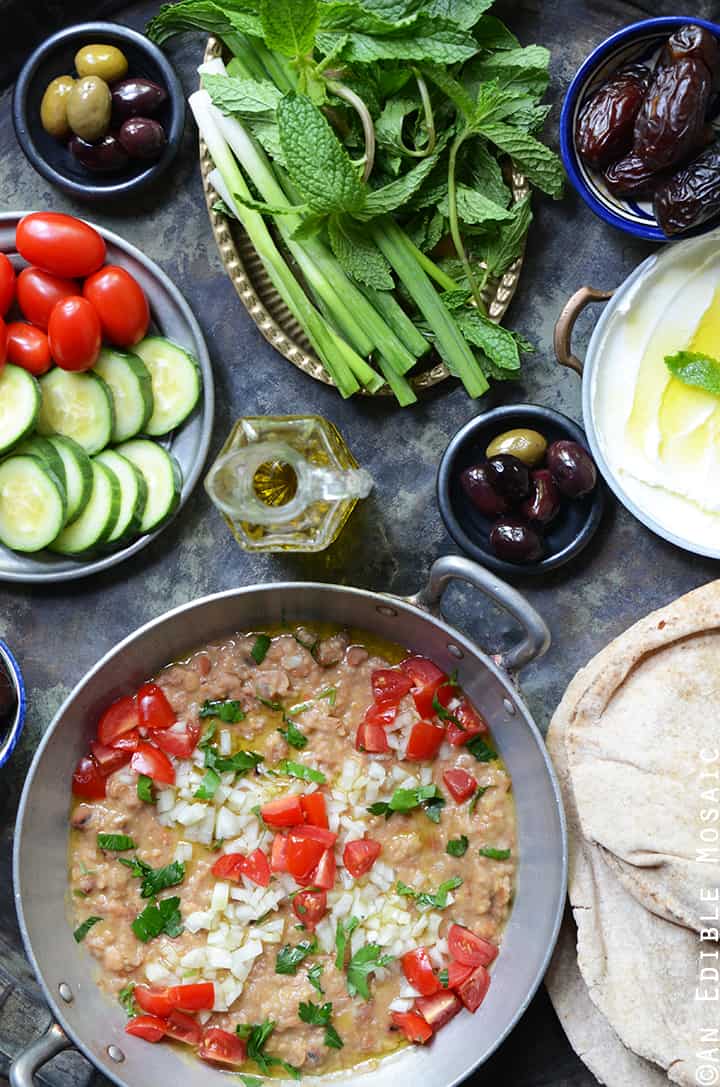
A bowl of oatmeal. Bacon and eggs. Pancakes. What's your favorite breakfast food?
The answer to that question most likely depends where you live. For me, French toast for breakfast always meant a special occasion growing up!
This beautiful dish of Egyptian fava beans is a popular breakfast in the Middle East. And what a wonderful way to start the day!
Creamy fava beans are seasoned with garlic, lemon, and cumin. Peppery olive oil adds richness, while fresh tomato, onion, and parsley brighten the flavor. It's perfect scooped up with flatbread.
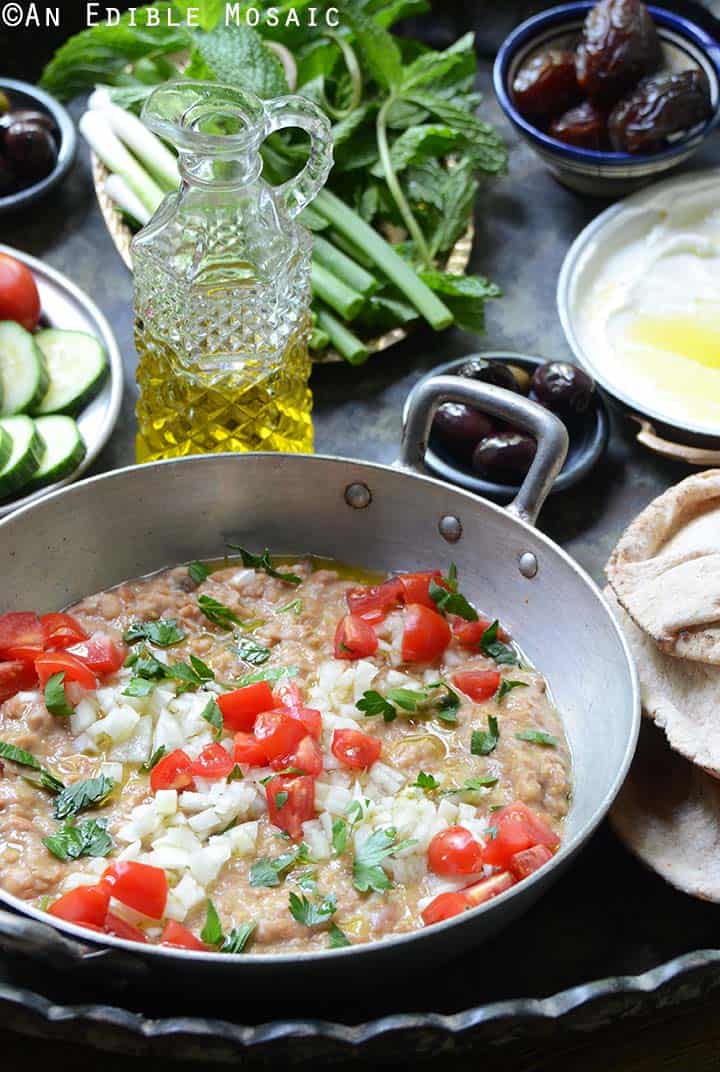
My Experience with Foul Mudammas in the Middle East
This is a classic Egyptian dish that’s commonly eaten for breakfast in the Middle East. When I was doing research for my cookbook and Mike and I were living in Damascus with his family, on Friday mornings (which are relaxed like our Sunday mornings here in the U.S.) Mike’s mom would send him out with a big empty bowl from home to the falafel/hummus/foul vendor down the street.
Mike would return to us with a full bowl of foul. It was steaming hot and ready to be devoured by the whole family.
His mom would have an entire spread prepared. Juicy ripe tomatoes, refreshing slices of cucumber, fresh mint, and tangy green onions. Labneh (yogurt cheese) topped with a healthy dose of olive oil, plump dates, homemade pickles, olives, fresh soft and aromatic flatbread from the baker across the street, tea, and perhaps halawa.
It was ordinary to them, but to me, it always felt special. That was where I learned how to make Ful Medames.
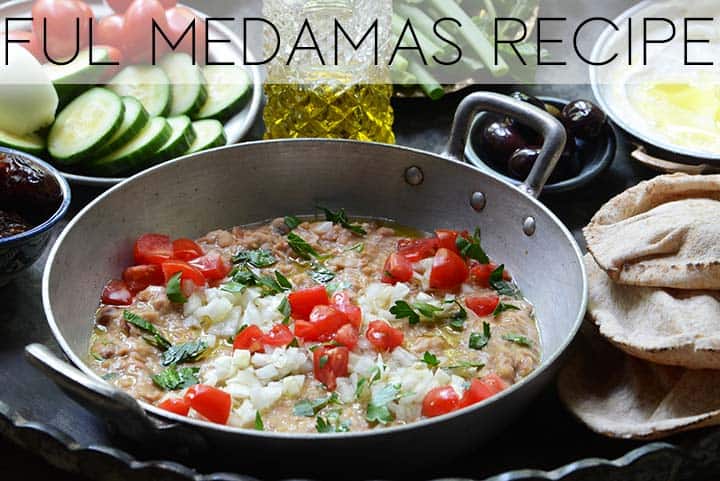
The Best Ful Medames Recipe
Ingredients
- Canned fava beans
- Canned chickpeas
- Water
- Garlic
- Salt
- Lemon
- Cumin
- Black pepper
- Tomato
- Onion
- Parsley
- Olive oil
How to Make Ful Medamas
- Bring the fava beans (with liquid), chickpeas, and water to a simmer in a medium saucepan over medium heat. Turn off heat and mash some of the beans (about ½ cup) against the side of the pot.
- Stir in the garlic, lemon juice, cumin, and black pepper.
- Transfer the beans to 1 large or 4 small serving dishes; drizzle on the olive oil and arrange the tomato, onion, and parsley decoratively on top.
- Serve with lemon wedges to squeeze on top.
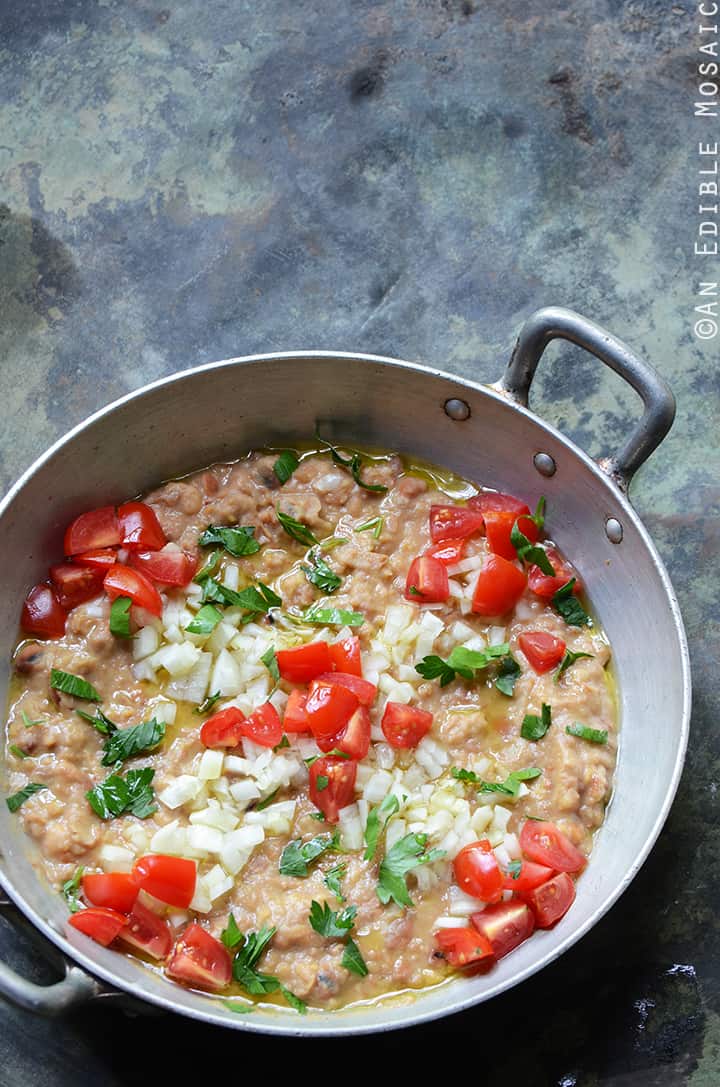
Variations on Foul Mudammas
- You can skip the chickpeas and use double the amount of fava beans.
- Add some spicy heat with 1 or 2 minced jalapenos added at the same time as the garlic. Garnish with sliced jalapeno. Or add cayenne pepper instead!
- Make it smoky with up to ½ teaspoon of smoked paprika.
Tips for Making Ful Mudammas
- If you prefer, you can use dried fava beans (instead of canned) to make Ful Medames. Cook the beans before making this recipe, and then proceed with the recipe the same way. (But note that using canned beans is a big time-saver, and this recipe doesn't suffer for it!)
- Don't forget to mash a few of the beans because that's what makes this dish so creamy. I like to mash about ½ a cup or so, and then give it a good stir.
- Serve this piping hot.
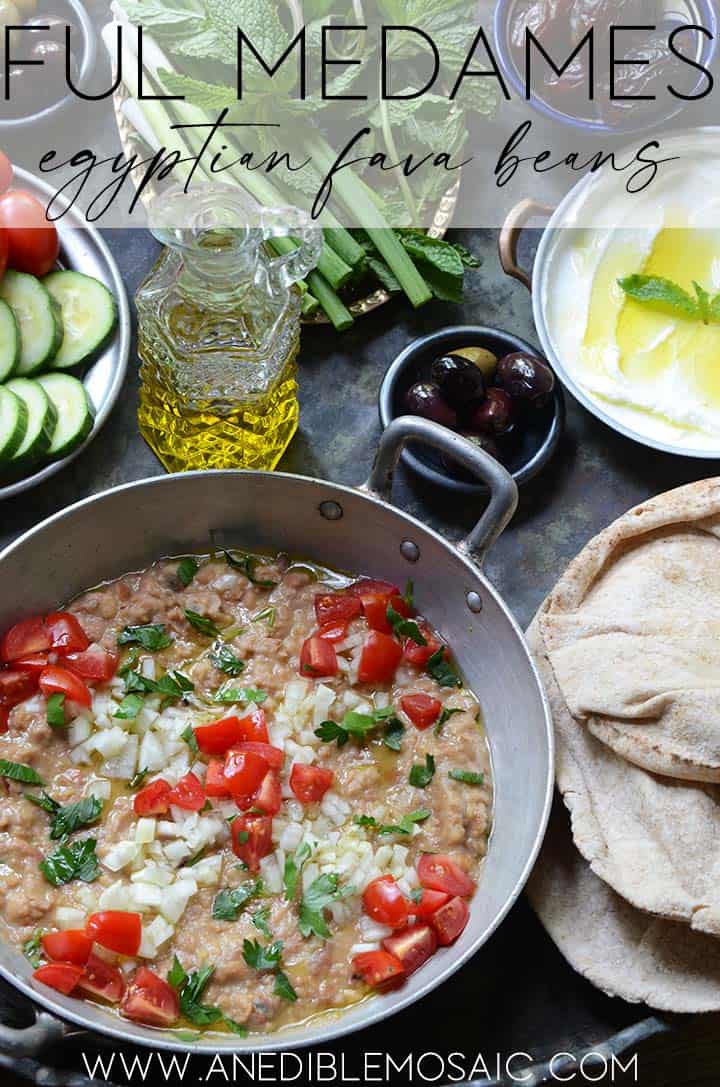
Foul Mudammas FAQs
What is Ful Medames?
Ful Medames, also transliterated Foul Mudammas or Foule Mudammes, is a dish of stewed fava beans topped with a few vegetables and a drizzle of olive oil.
It's a common meal in Egypt (most notably breakfast), and it's also eaten in other areas of the Middle East.
You can read more about Ful Medames on Wikipedia.
Are Butter Beans and Fava Beans the Same?
No, these are different types of beans. Another name for butter beans is lima beans, and another name for fava beans is broad beans.
Both types of beans have a similar shape and color when cooked. However, they do have some notable differences:
- The seed location is the middle of lima beans, and at one end of fava beans.
- Lima beans have a soft, starchy texture, and fava beans are much firmer.
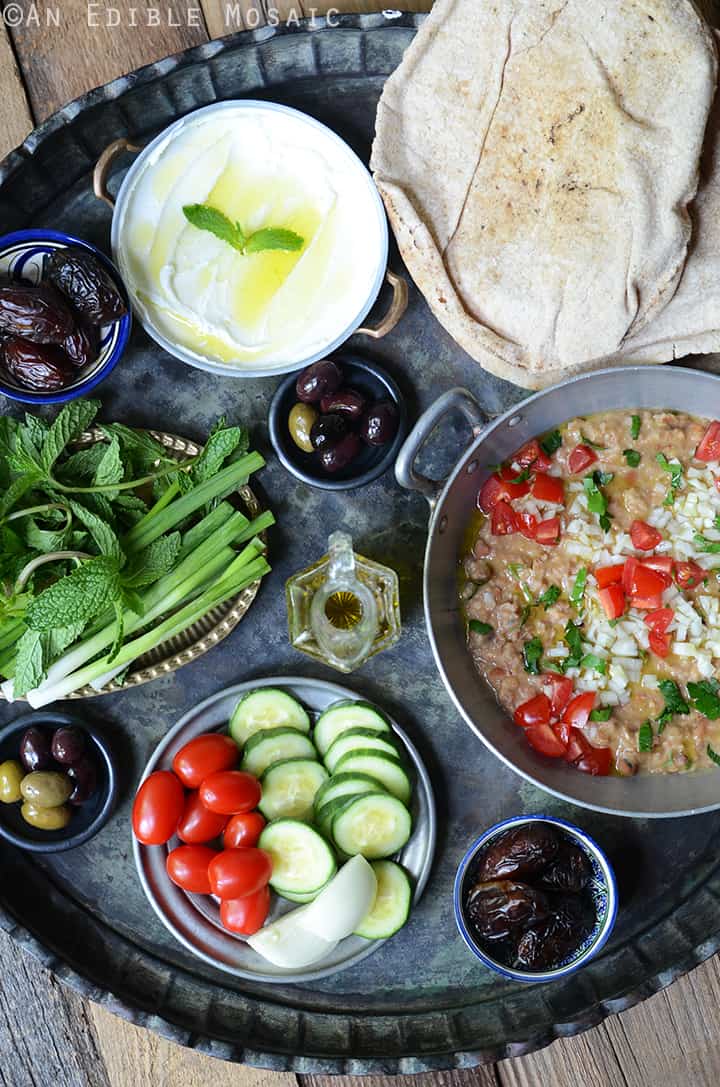
Is Ful Mudames Healthy?
This is a very subjective question, and will likely vary by person. It's a vegan meal with a decent source of plant-based protein, fiber, and nutrients.
Here is the Nutrition Information for 1 Serving of Ful Medames:
- 318kcals
- 34g carbohydrates
- 12g protein
- 17g fat
- 10g fiber
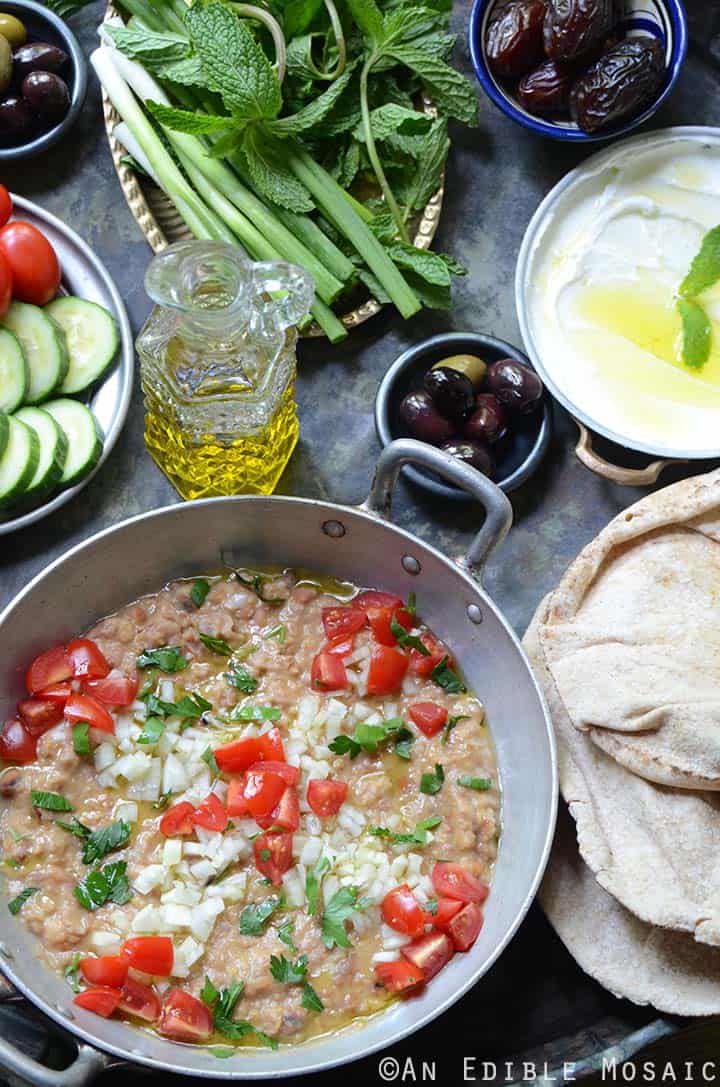
A Middle Eastern-Themed Food Blogger Collaboration
I was recently thrilled when the very talented Ksenia of At the Immigrant’s Table reached out to me with an idea to collaborate on a post.
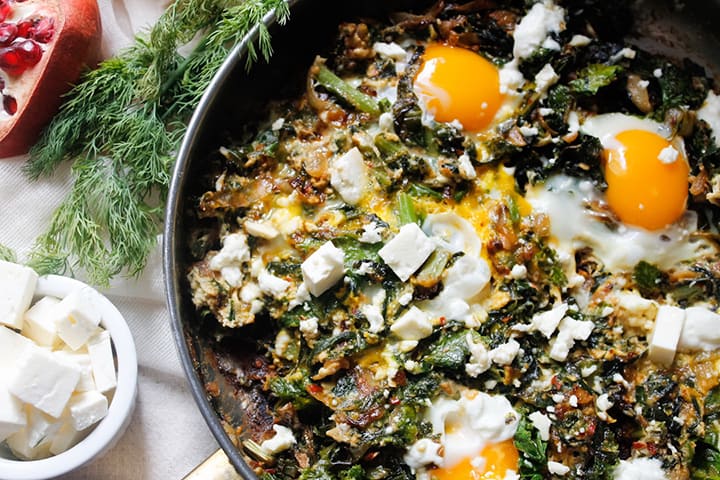
Ksenia is a poignant writer, gifted photographer, and healthy recipe developer. Her recipes are innovative, inspirational, and insightful. To name just a few of my favorites, check out her beautiful Russian Korean-Style Kohlrabi Salad with Apples, Radishes, and Spicy Salad Topper, Roasted Cauliflower Steaks on Spicy Sweet Potato Puree, and Middle Eastern Spiced Butternut Squash Pickles.
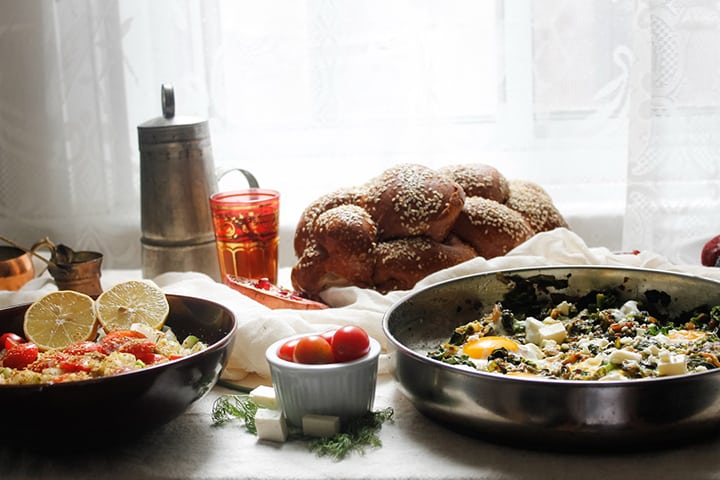
As Ksenia and I were talking over email, our mutual love of Middle Eastern food stood out as a common thread between us. We decided to go with that as our theme, choosing to each share a Middle Eastern-inspired breakfast spread. She made an absolutely stunning Israeli Green Shakshuka, which is vibrant and perfect for spring.
Both of our recipes are vegetarian, but they’re completely different in flavor, showcasing the true range of Middle Eastern cuisine. Our dishes are both healthy and nourishing. They are total comfort food that work well beyond breakfast, for any meal of the day.
More Delicious Middle Eastern Recipes to Try
- Shish Tawook (Middle Eastern Grilled Chicken Skewers)
- Toum (Midlde Eastern Garlic Sauce)
- Arabic Breakfast
- Red Lentil Soup
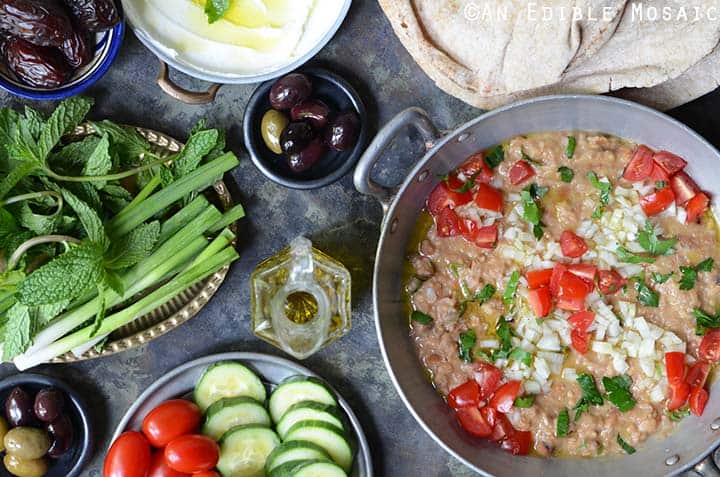
Let's Connect

Did you make this recipe? Please rate it and leave a comment below. You can also tag @anediblemosaic on social media.
To stay up-to-date, follow me on Facebook, Instagram, Pinterest, and Twitter!
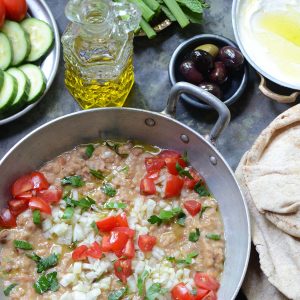
Ful Medames
Ingredients
- 2 cloves garlic crushed
- ½ teaspoon salt
- 15 ounce can fava beans sometimes called broad beans or foul mudammas, with liquid
- 15 ounce can chickpeas rinsed and drained
- ½ cup water
- 1 tablespoon fresh lemon juice
- 1 teaspoon cumin
- ¼ teaspoon freshly ground black pepper
- 1 small tomato diced
- ½ small onion minced
- 4 tablespoons minced fresh parsley leaves
- 4 tablespoons olive oil
- 1 lemon wedged
Instructions
- Crush the garlic in a mortar and pestle with the salt.
- Bring the fava beans (with liquid), chickpeas, and water to a simmer in a medium saucepan over medium heat. Turn off heat and use the back of a spoon to mash some of the beans (about ½ cup) against the side of the pot.
- Stir in the garlic, lemon juice, cumin, and black pepper.
- Transfer the beans to 1 large or 4 small serving dishes; drizzle on the olive oil and arrange the tomato, onion, and parsley on top in a decorative way.
- Serve with lemon wedges to squeeze on top.
Faith's Tips
- Recipe Inspiration: This recipe is from my cookbook An Edible Mosaic: Middle Eastern Fare with Extraordinary Flair (Tuttle Publishing; 2012).
Nutrition
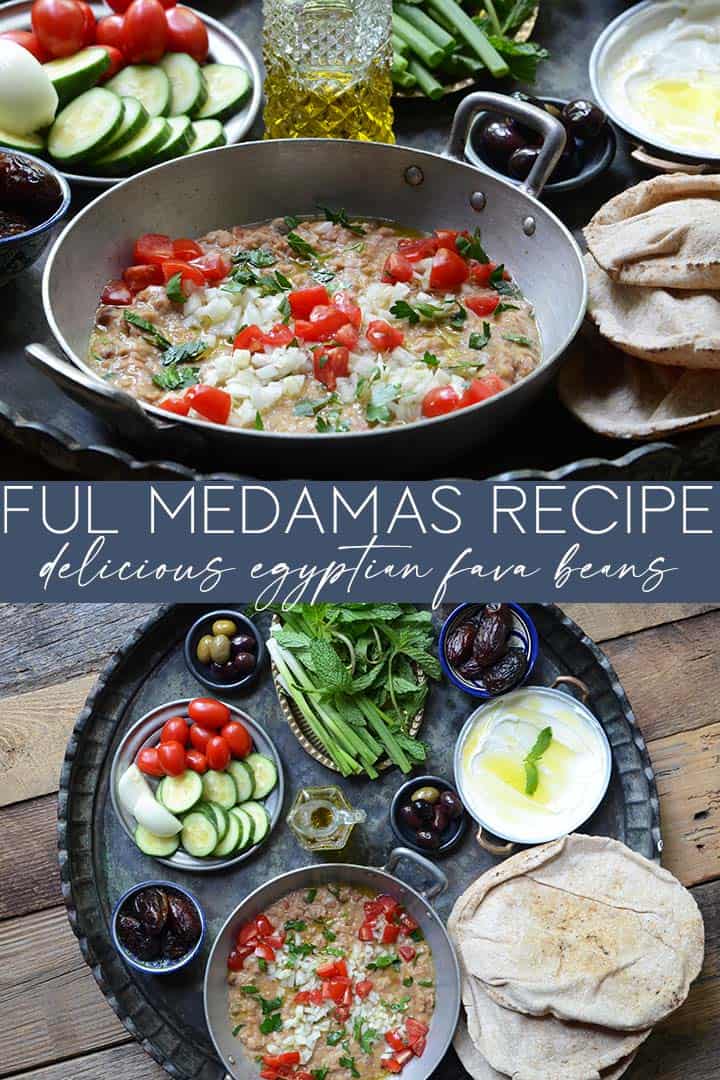
This post was first published on An Edible Mosaic on June 8, 2015. I updated it with more information on August 27, 2021.

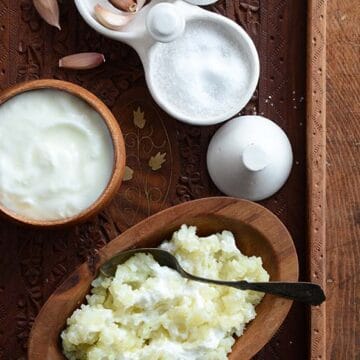
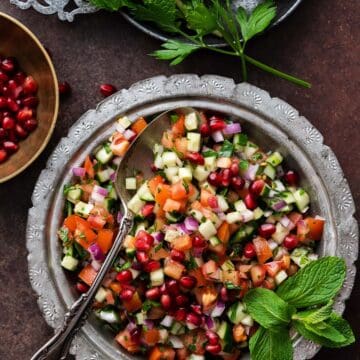
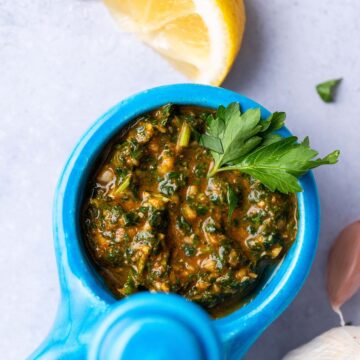
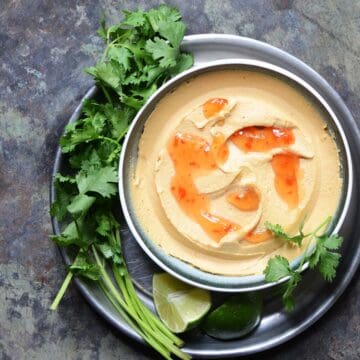
MrGleamMusic says
I am doing this for Ramadan, inspired by my good Egyptian friend Ismet. I searched for a few recipes online to inspire the version I will cook after sunset. Your pictures are very beautiful. Have a great day <3 MrGleamMusic
Naomi says
This was the exact right taste! Thank you.
Sonny Tristan says
Retired from Aramco in Saudi. They had a dish almost like Foul's except it was more reddish in color and had squashed tomatoes and onions and oil on top. Also ate with stone oven Arabic bread. Please tell me the name of this other dish
Shukran
Sonny
Elizabeth says
Even without your exquisite photography, Faith, the wonderful experiences and warm memories that you share, paint a beautiful picture of the food you’re showing people how to make!
I remember years ago, you said that in the Middle East, food is so much more than just food - it’s the very core of their cultural interaction. The proverbial glue holding them together! How wonderful, to see such an important aspect of Middle Eastern life brought so poignantly to life on your blog!
the kiddd says
This is a fabulous dish and easy to make. If you want to make it better peel the beans and it turn this meal into something off the charts. just makes the beans so tender. Totally off the chart.
Annie @ Annie's Noms says
Oooh this looks delicious! So colourful!
Steph @ Steph in Thyme says
What a stunning dish, and thank you for the information about Ramadan. I had a wonderful fava bean dish in Greece a few years ago, so warm and full of flavor. I need to try this dish, the flavor profile is right up my alley. Simply divine.
Matt @ Plating Pixels says
Ethnic dishes like this are so intriguing. Sounds like a hearty and healthy vegan dish! I don't normally cook vegan but would totally go for this.
Becca @ Crumbs and Chaos says
The flavors of this amazing dish make me want to drool all over my keyboard :) YUM!
Brandon @ Kitchen Konfidence says
I'm sure these flavors just jump right off the plate. I wish I was eating this for dinner tonight!
Christina @ Christina's Cucina says
Love these shots, and of course, I'd love to be right in front of that table eating everything on it, too! Such a lovely, and healthy dish...how could anyone not enjoy this?
Joanne says
I have a deep respect for anyone who observes Ramadan to its completion...it is no easy task especially when you live in a society where the majority of people aren't observing. I'm sure it's much easier when everyone you know is also fasting. Love the sound of this dish. Fava beans sound so good!
Laura @ Family Spice says
We Persians love our fava beans, too. What a beautiful platter you have put together. This looks incredible to eat whether you are breaking a fast or not!
Cynthia/What A Girl Eats says
What a gorgeous looking spread! i want to dive right in!
Eileen says
This sounds fantastic! Every time I've had "foul," it's been whole beans in an herby vinaigrette, so this is super interesting and different! (Clearly "foul" just means "fava beans" or even "beans," huh.) Definitely going to give it a try!
Michelle@healthiersteps says
Absolutely delicious, love the simplicity of your recipe and the flavors!
jenna @ just j.faye says
Faith, this looks delicious! Your photos are gorgeous and I enjoyed reading a little about Ramadan. Thanks for sharing!
Kiano says
This whole spread looks delicious & nutritious, but I CANNOT ignore this amazing food styling. Brava!
Jerry says
Yes, please. I'll take mine served in a five gallon bucket. this looks freaking amazing! I also love fava beans, but this is the fist time I've seen this recipe. will be trying it next week!
Christina @ but i'm hungry says
Wow, this sounds wonderful... any tips on making this with fresh favas? I have some I found at the market last week that I'm looking for a special use for... this just might be it!
Faith says
Christina, You could definitely do fresh favas with the same flavors going on in this dish! Just remove the beans from their pods, blanch them for about 2 minutes, plunge into an ice bath, slip off the skins, and then saute the beans in olive oil with garlic for 3 to 5 minutes. Once done, add a squeeze of fresh lemon and any chopped herbs you like!
Marissa | Pinch and Swirl says
Faith, thank you for this! What a tender and admirable explanation of Ramadan. I'm happy to better understand what it's all about.
I haven't made a dish like this before, but I love everything about it. It looks delicious and looks like it would be fun to share with friends and family. xo
Becky Winkler (A Calculated Whisk) says
This sounds great (and that whole Friday morning breakfast spread sounds beyond amazing). Glad to discover Ksenia's blog, too!
Rosa says
Scrumptious and perfect with flatbread.
Cheers,
Rosa